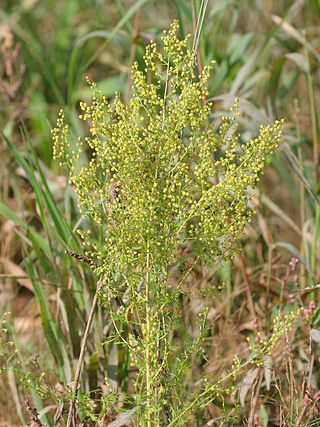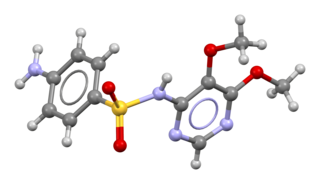Related Research Articles

Malaria is a mosquito-borne infectious disease that affects humans and other vertebrates. Human malaria causes symptoms that typically include fever, fatigue, vomiting, and headaches. In severe cases, it can cause jaundice, seizures, coma, or death. Symptoms usually begin 10 to 15 days after being bitten by an infected Anopheles mosquito. If not properly treated, people may have recurrences of the disease months later. In those who have recently survived an infection, reinfection usually causes milder symptoms. This partial resistance disappears over months to years if the person has no continuing exposure to malaria.
Antimalarial medications or simply antimalarials are a type of antiparasitic chemical agent, often naturally derived, that can be used to treat or to prevent malaria, in the latter case, most often aiming at two susceptible target groups, young children and pregnant women. As of 2018, modern treatments, including for severe malaria, continued to depend on therapies deriving historically from quinine and artesunate, both parenteral (injectable) drugs, expanding from there into the many classes of available modern drugs. Incidence and distribution of the disease is expected to remain high, globally, for many years to come; moreover, known antimalarial drugs have repeatedly been observed to elicit resistance in the malaria parasite—including for combination therapies featuring artemisinin, a drug of last resort, where resistance has now been observed in Southeast Asia. As such, the needs for new antimalarial agents and new strategies of treatment remain important priorities in tropical medicine. As well, despite very positive outcomes from many modern treatments, serious side effects can impact some individuals taking standard doses.

Artemisia annua, also known as sweet wormwood, sweet annie, sweet sagewort, annual mugwort or annual wormwood, is a common type of wormwood native to temperate Asia, but naturalized in many countries including scattered parts of North America.

Artemisinin and its semisynthetic derivatives are a group of drugs used in the treatment of malaria due to Plasmodium falciparum. It was discovered in 1972 by Tu Youyou, who shared the 2015 Nobel Prize in Physiology or Medicine for her discovery. Artemisinin-based combination therapies (ACTs) are now standard treatment worldwide for P. falciparum malaria as well as malaria due to other species of Plasmodium. Artemisinin is extracted from the plant Artemisia annua a herb employed in Chinese traditional medicine. A precursor compound can be produced using a genetically engineered yeast, which is much more efficient than using the plant.

Artesunate (AS) is a medication used to treat malaria. The intravenous form is preferred to quinine for severe malaria. Often it is used as part of combination therapy, such as artesunate plus mefloquine. It is not used for the prevention of malaria. Artesunate can be given by injection into a vein, injection into a muscle, by mouth, and by rectum.
Artemether/lumefantrine, sold under the trade name Coartem among others, is a combination of the two medications artemether and lumefantrine. It is used to treat malaria caused by Plasmodium falciparum that is not treatable with chloroquine. It is not typically used to prevent malaria. It is taken by mouth.
Artesunate suppositories are used for the treatment of malaria. Artesunate is an antimalarial water-soluble derivative of dihydroartemisinin. Artemisinins are sesquiterpene lactones isolated from Artemisia annua, a Chinese traditional medicine. These suppositories are given rectally due to the risk of death from severe malaria, as described below.
Malaria prophylaxis is the preventive treatment of malaria. Several malaria vaccines are under development.

Amodiaquine (ADQ) is a medication used to treat malaria, including Plasmodium falciparum malaria when uncomplicated. It is recommended to be given with artesunate to reduce the risk of resistance. Due to the risk of rare but serious side effects, it is not generally recommended to prevent malaria. Though, the WHO in 2013 recommended use for seasonal preventive in children at high risk in combination with sulfadoxine and pyrimethamine.

Sulfadoxine is an ultra-long-lasting sulfonamide used in combination with pyrimethamine to treat malaria.

The administration of drugs to whole populations irrespective of disease status is referred to as mass drug administration (MDA) or mass dispensing.

The Chagas: Time to Treat Campaign is an international campaign started by the Drugs for Neglected Diseases initiative to advocate for increased research and development of treatments for Chagas disease. Chagas is a potentially fatal neglected disease that affects between 8 and 13 million people worldwide. DNDi's Time to Treat campaign is pushing for increased political interest in new treatments for Chagas disease, increased public awareness of the disease and treatment limitations and increased public and private investment in R&D.

Chlorproguanil is an antimalarial drug. In the late 90s and early 2000s, it was studied under collaboration with the UNICEF/UNDP/World Bank Special Program for Research and Training on Tropical Diseases and GlaxoSmithKline. It was a potential alternative to the preexisting combination therapy of chloroquine and sulfadoxine/pyrimethamine, as malaria was showing drug resistance to this approach. It has been trialled in combination therapy with artesunate to treat haemolysis after malaria treatment, however its development was prematurely stopped because of safety concerns secondary to its associated risk of haemolytic anaemia in individuals with glucose-6-phosphate dehydrogenase deficiency.
Project 523 is a code name for a 1967 secret military project of the People's Republic of China to find antimalarial medications. Named after the date the project launched, 23 May, it addressed malaria, an important threat in the Vietnam War. At the behest of Ho Chi Minh, Prime Minister of North Vietnam, Zhou Enlai, the Premier of the People's Republic of China, convinced Mao Zedong, Chairman of the Chinese Communist Party, to start the mass project "to keep [the] allies' troops combat-ready", as the meeting minutes put it. More than 500 Chinese scientists were recruited. The project was divided into three streams. The one for investigating traditional Chinese medicine discovered and led to the development of a class of new antimalarial drugs called artemisinins. Launched during and lasting throughout the Cultural Revolution, Project 523 was officially terminated in 1981.
Pregnancy-associated malaria (PAM) or placental malaria is a presentation of the common illness that is particularly life-threatening to both mother and developing fetus. PAM is caused primarily by infection with Plasmodium falciparum, the most dangerous of the four species of malaria-causing parasites that infect humans. During pregnancy, a woman faces a much higher risk of contracting malaria and of associated complications. Prevention and treatment of malaria are essential components of prenatal care in areas where the parasite is endemic – tropical and subtropical geographic areas. Placental malaria has also been demonstrated to occur in animal models, including in rodent and non-human primate models.
Sulfadoxine/pyrimethamine, sold under the brand name Fansidar, is a combination medication used to treat malaria. It contains sulfadoxine and pyrimethamine. For the treatment of malaria it is typically used along with other antimalarial medication such as artesunate. In areas of Africa with moderate to high rates of malaria, three doses are recommended during the second and third trimester of pregnancy.
The Affordable Medicines Facility-malaria (AMFm) is a financing mechanism intended to expand access to affordable and effective antimalarial medication. It works primarily through the commercial private sector, in addition to the public and non-governmental organization sectors which are the more traditional routes for development assistance in malaria control. Its goal is to drive down the price of the most effective malaria medicines so that millions of people can afford to buy them. The program has been called "one of the most important recent advances in fighting malaria" and "a triumph of international cooperation." The AMFm is hosted and managed by the Global Fund to Fight AIDS, Tuberculosis and Malaria in Geneva, Switzerland.
Sanaria is a biotechnology company developing vaccines protective against malaria and other infectious diseases as well as related products for use in malaria research. Sanaria's vaccines are based on the use of the sporozoite (SPZ) stage of the malaria parasite, Plasmodium, as an immunogen, and as a platform technology for liver-vectored gene delivery. SPZ are normally introduced into humans by mosquito bite where they migrate to the liver and further develop to liver stages, and eventually back into the blood stream where the parasite infects red blood cells (RBC) and causes malaria. Plasmodium falciparum is the species responsible for more than 95% deaths caused by malaria. The WHO estimates there were 249 million clinical cases and 608,000 deaths in 2022 alone.
Risankizumab, sold under the brand name Skyrizi, is a humanized monoclonal antibody used for the treatment of plaque psoriasis, psoriatic arthritis, and Crohn's disease. It is designed to target interleukin 23A (IL-23A). It is given by subcutaneous injection.

Clive Ballard is a British, world-leading expert in dementia. He is currently Professor of Age-Related Diseases at the University of Exeter and Interim Deputy Pro-Vice-Chancellor and Dean of the University of Exeter Medical School.
References
- ↑ Schellenberg D, Menendez C, Kahigwa E, Aponte J, Vidal J, Tanner M, et al. Intermittent treatment for malaria and anaemia control at time of routine vaccinations in Tanzanian infants: a randomised, placebo-controlled trial. Lancet 2001;357(9267):1471-7
- ↑ Schellenberg D, Menendez C, Aponte JJ, Kahigwa E, Tanner M, Mshinda H, et al. Intermittent preventive antimalarial treatment for Tanzanian infants: follow-up to age 2 years of a randomised, placebo-controlled trial. Lancet 2005;365(9469):1481-3
- ↑ Massaga JJ, Kitua AY, Lemnge MM, Akida JA, Malle LN, Ronn AM, et al. Effect of intermittent treatment with amodiaquine on anaemia and malarial fevers in infants in Tanzania: a randomised placebo-controlled trial. Lancet 2003;361(9372):1853-60
- ↑ Chandramohan D, Owusu-Agyei S, Carneiro I, Awine T, Amponsa-Achiano K, Mensah N, et al. Cluster randomised trial of intermittent preventive treatment for malaria in infants in area of high, seasonal transmission in Ghana. BMJ 2005;331(7519):727-33
- ↑ Macete E, Aide P, Aponte JJ, Sanz S, Mandomando I, Espasa M, et al. Intermittent preventive treatment for malaria control administered at the time of routine vaccinations in Mozambican infants: a randomized, placebo-controlled trial. J Infect Dis 2006;194(3):276-85
- ↑ Grobusch MP, Lell B, Schwarz NG, Gabor J, Dornemann J, Potschke M, et al. Intermittent preventive treatment against malaria in infants in Gabon--a randomized, double-blind, placebo-controlled trial. J Infect Dis 2007;196(11):1595-602
- ↑ Kobbe R, Kreuzberg C, Adjei S, Thompson B, Langefeld I, Thompson PA, et al. A randomized controlled trial of extended intermittent preventive antimalarial treatment in infants. Clin Infect Dis 2007;45(1):16-25
- ↑ Mockenhaupt FP, Reither K, Zanger P, Roepcke F, Danquah I, Saad E, et al. Intermittent preventive treatment in infants as a means of malaria control: a randomized, double-blind, placebo-controlled trial in northern Ghana. Antimicrob Agents Chemother 2007;51(9):3273-81
- ↑ Armstrong Schellenberg, J.R., et al., Community effectiveness of Intermittent Preventive Treatment for infants (IPTi) in rural southern Tanzania. Am J Trop Med Hyg, 2010. 82(5): p. 772-81.
- ↑ .Cisse B, Sokhna C, Boulanger D, Milet J, Ba el H, Richardson K, et al. Seasonal intermittent preventive treatment with artesunate and sulfadoxine-pyrimethamine for prevention of malaria in Senegalese children: a randomised, placebo-controlled, double-blind trial. Lancet 2006;367(9511):659-67
- ↑ Dicko A, Sagara I, Sissoko MS, Guindo O, Diallo AI, Kone M, et al. Impact of intermittent preventive treatment with sulphadoxine-pyrimethamine targeting the transmission season on the incidence of clinical malaria in children in Mali. Malar J 2008;7:123
- ↑ Clarke SE, Jukes MC, Njagi JK, Khasakhala L, Cundill B, Otido J, et al. Effect of intermittent preventive treatment of malaria on health and education in schoolchildren: a cluster-randomised, double-blind, placebo-controlled trial. Lancet 2008;372(9633):127-38
- ↑ WHO. A strategic framework for malaria prevention and control during pregnancy in the Africa Region. Geneva: WorldHealthOrganization, 2004 AFR/MAL/04/01
- ↑ Shulman CE, Dorman EK, Cutts F, Kawuondo K, Bulmer JN, Peshu N, et al. Intermittent sulphadoxine-pyrimethamine to prevent severe anaemia secondary to malaria in pregnancy: a randomised placebo-controlled trial. Lancet 1999;353(9153):632-6
- ↑ Challis K, Osman NB, Cotiro M, Nordahl G, Dgedge M, Bergstrom S. Impact of a double dose of sulphadoxine-pyrimethamine to reduce prevalence of pregnancy malaria in southern Mozambique. Trop Med Int Health 2004;9(10):1066-73
- ↑ Kayentao K, Kodio M, Newman RD, Maiga H, Doumtabe D, Ongoiba A, et al. Comparison of intermittent preventive treatment with chemoprophylaxis for the prevention of malaria during pregnancy in Mali. J Infect Dis 2005;191(1):109-16
- ↑ Njagi JK, Magnussen P, Estambale B, Ouma J, Mugo B. Prevention of anaemia in pregnancy using insecticide-treated bednets and sulfadoxine-pyrimethamine in a highly malarious area of Kenya: a randomized controlled trial. Trans R Soc Trop Med Hyg 2003;97(3):277-82
- ↑ Parise ME, Ayisi JG, Nahlen BL, Schultz LJ, Roberts JM, Misore A, et al. Efficacy of sulfadoxine-pyrimethamine for prevention of placental malaria in an area of Kenya with a high prevalence of malaria and human immunodeficiency virus infection. Am J Trop Med Hyg 1998;59(5):813-22
- ↑ Rogerson SJ, Chaluluka E, Kanjala M, Mkundika P, Mhango C, Molyneux ME. Intermittent sulfadoxine-pyrimethamine in pregnancy: effectiveness against malaria morbidity in Blantyre, Malawi, in 1997-99. Trans R Soc Trop Med Hyg 2000;94(5):549-53
- ↑ van Eijk AM, Ayisi JG, ter Kuile FO, Otieno JA, Misore AO, Odondi JO, et al. Effectiveness of intermittent preventive treatment with sulphadoxine-pyrimethamine for control of malaria in pregnancy in western Kenya: a hospital-based study. Trop Med Int Health 2004;9(3):351-60
- ↑ Verhoeff FH, Brabin BJ, Chimsuku L, Kazembe P, Russell WB, Broadhead RL. An evaluation of the effects of intermittent sulfadoxine-pyrimethamine treatment in pregnancy on parasite clearance and risk of low birth weight in rural Malawi. Ann Trop Med Parasitol 1998;92(2):141-50
- ↑ Harrington WE, Mutabingwa TK, Muehlenbachs A, Sorensen B, Bolla MC, Fried M, et al. Competitive facilitation of drug-resistant Plasmodium falciparum malaria parasites in pregnant women who receive preventive treatment. Proc Natl Acad Sci U S A 2009;106(22):9027-32
- ↑ Intermittent preventive antimalarial treatment in infancy. Lancet 2008;372(9647):1383-4
- ↑
- Gesase S, Gosling RD, Hashim R, Ord R, Naidoo I, Madebe R, et al. High resistance of Plasmodium falciparum to sulphadoxine/pyrimethamine in northern Tanzania and the emergence of dhps resistance mutation at Codon 581. PLoS ONE 2009;4(2):e4569
- ↑ McGready, R., Intermittent preventive treatment of malaria in infancy. Lancet, 2009. 9700(374): p. 1478-80.
- ↑ .Schellenberg D, Cisse B, Menendez C. The IPTi Consortium: research for policy and action. Trends Parasitol 2006;22(7):296-300
- ↑ McNeil, Donald G. (16 February 2008). "Gates Foundation's Influence Criticized". The New York Times. Retrieved 30 November 2023.
- ↑ Committee on the Perspectives on the Role of Intermittent Preventive Treatment for Malaria in Infants. Assessment of the role of intermittent preventive treatment for malaria in infants: letter report. Washington, DC:Institute f Medicine, 2008. Assessment of the Role of Intermittent Preventive Treatment for Malaria in Infants: Letter Report | The National Academies Press. National Academies Press. 2008. doi:10.17226/12180. ISBN 978-0-309-11908-5. PMID 25009899.
- ↑ "WHO | WHO Policy recommendation on Intermittent Preventive Treatment during infancy with sulphadoxine-pyrimethamine (SP-IPTi) for Plasmodium falciparum malaria control in Africa". www.who.int. Archived from the original on 27 May 2010. Retrieved 15 January 2022.
- ↑ O'Meara, W.P., et al., Effect of a fall in malaria transmission on morbidity and mortality in Kilifi, Kenya. Lancet, 2008. 372(9649): p. 1555-62. 3.
- ↑ Ceesay, S.J., et al., Changes in malaria indices between 1999 and 2007 in The Gambia: a retrospective analysis. Lancet, 2008. 372(9649): p. 1545-54
- ↑ Gesase, S., et al., High resistance of Plasmodium falciparum to sulphadoxine/pyrimethamine in northern Tanzania and the emergence of dhps resistance mutation at Codon 581. PLoS ONE, 2009. 4(2): p. e4569.
- ↑ Raman, J., et al., Five years of large-scale dhfr and dhps mutation surveillance following the phased implementation of artesunate plus sulfadoxine-pyrimethamine in Maputo Province, Southern Mozambique. Am J Trop Med Hyg, 2010. 82(5): p. 788-94.